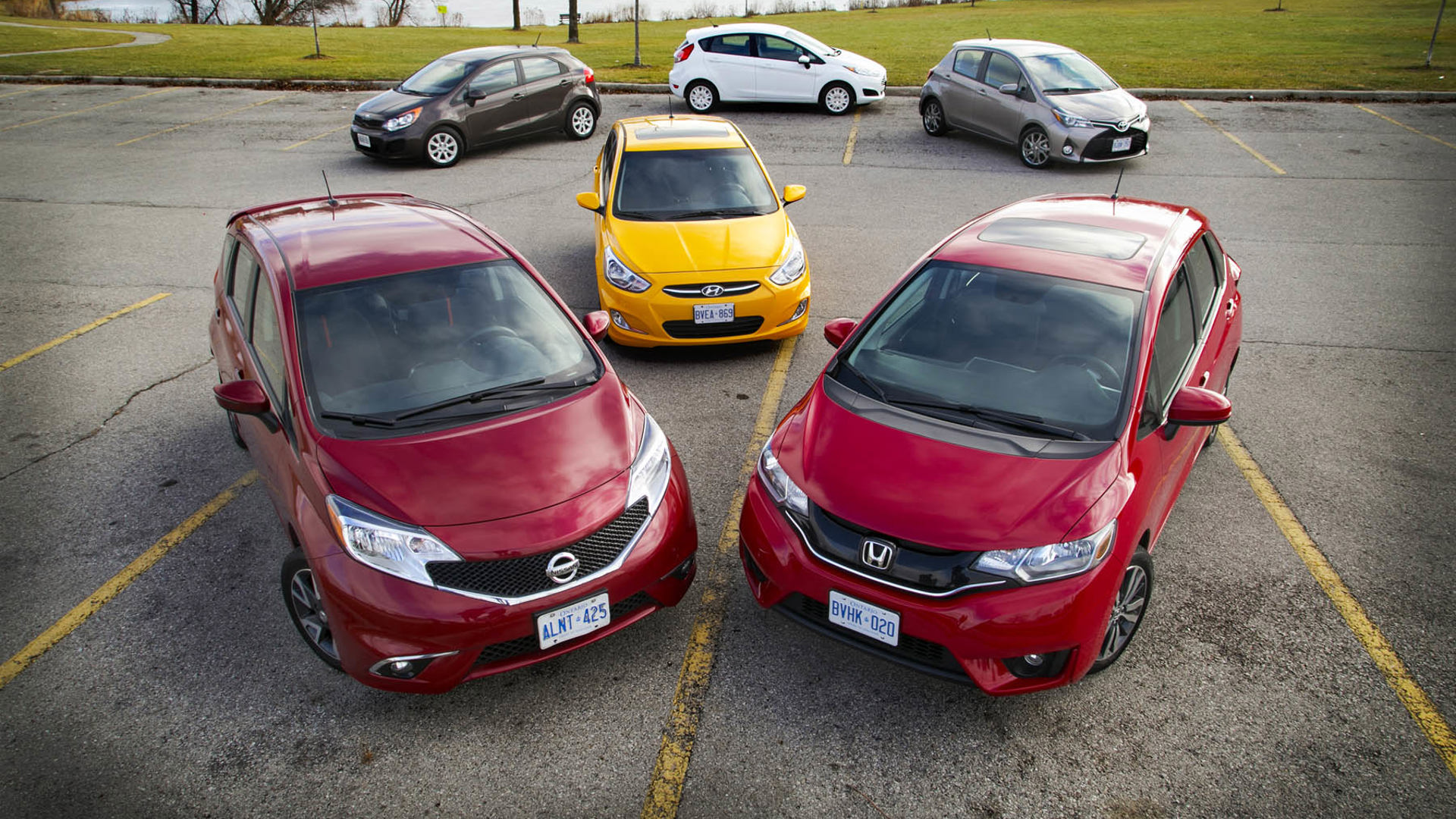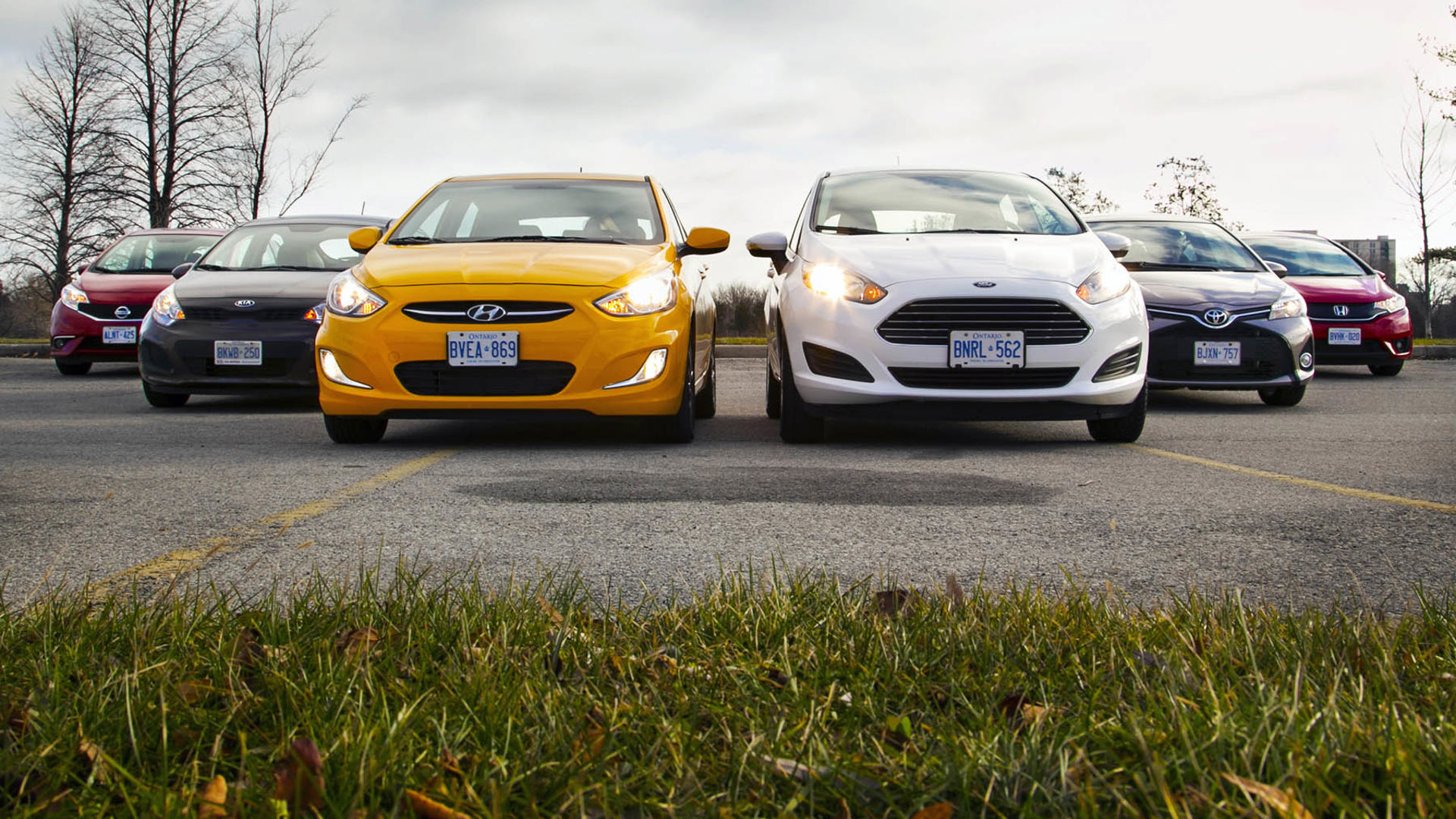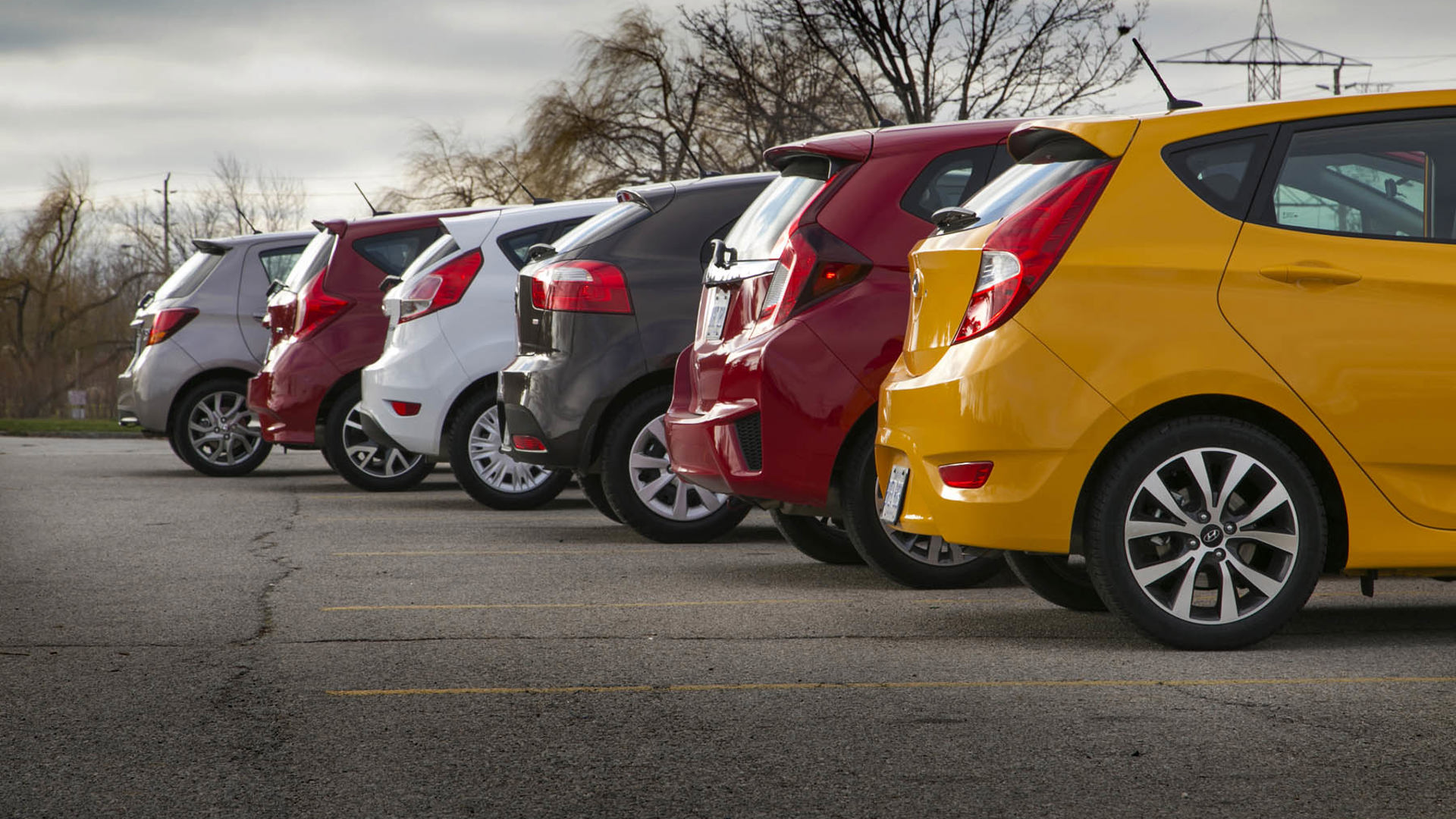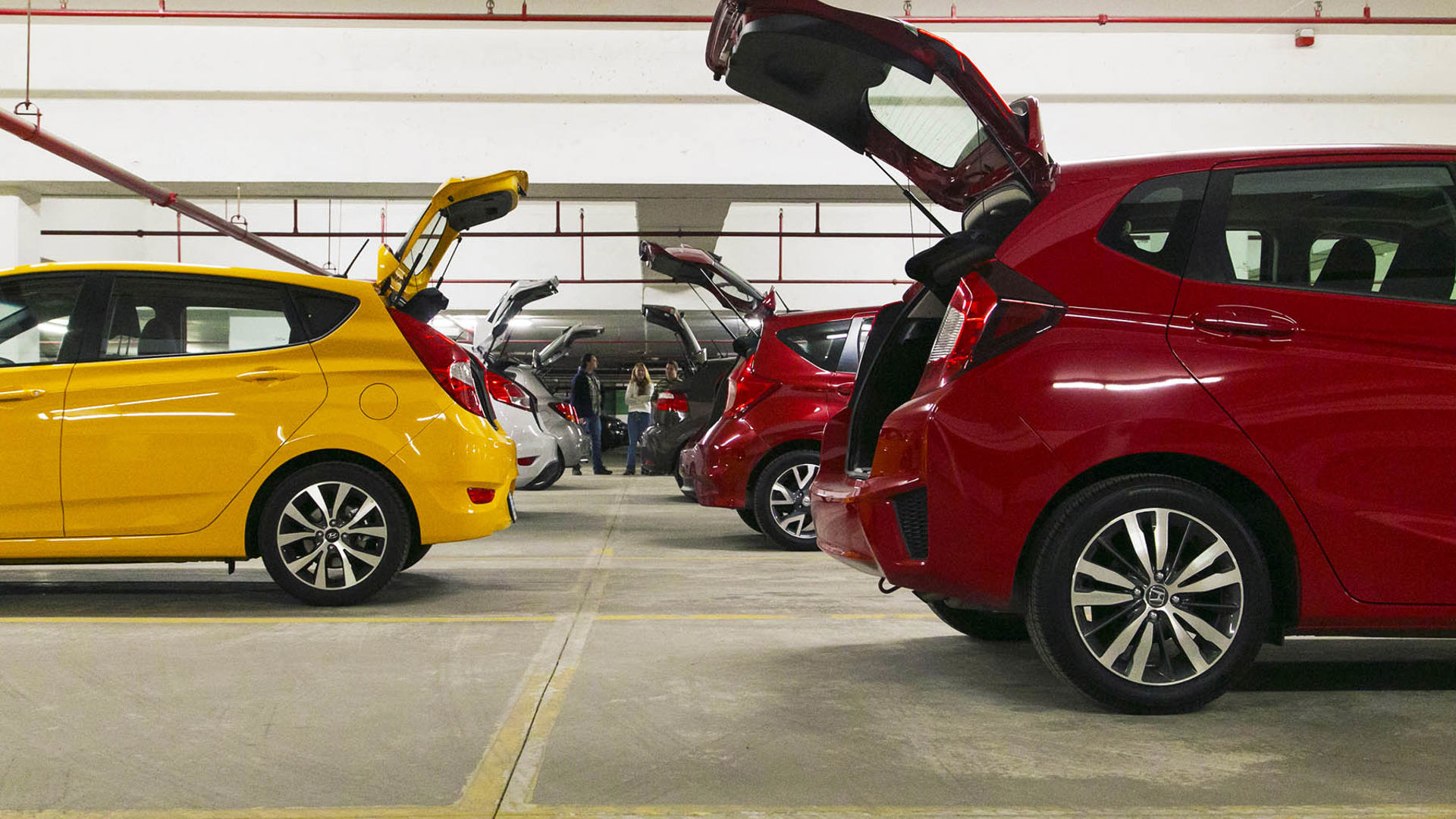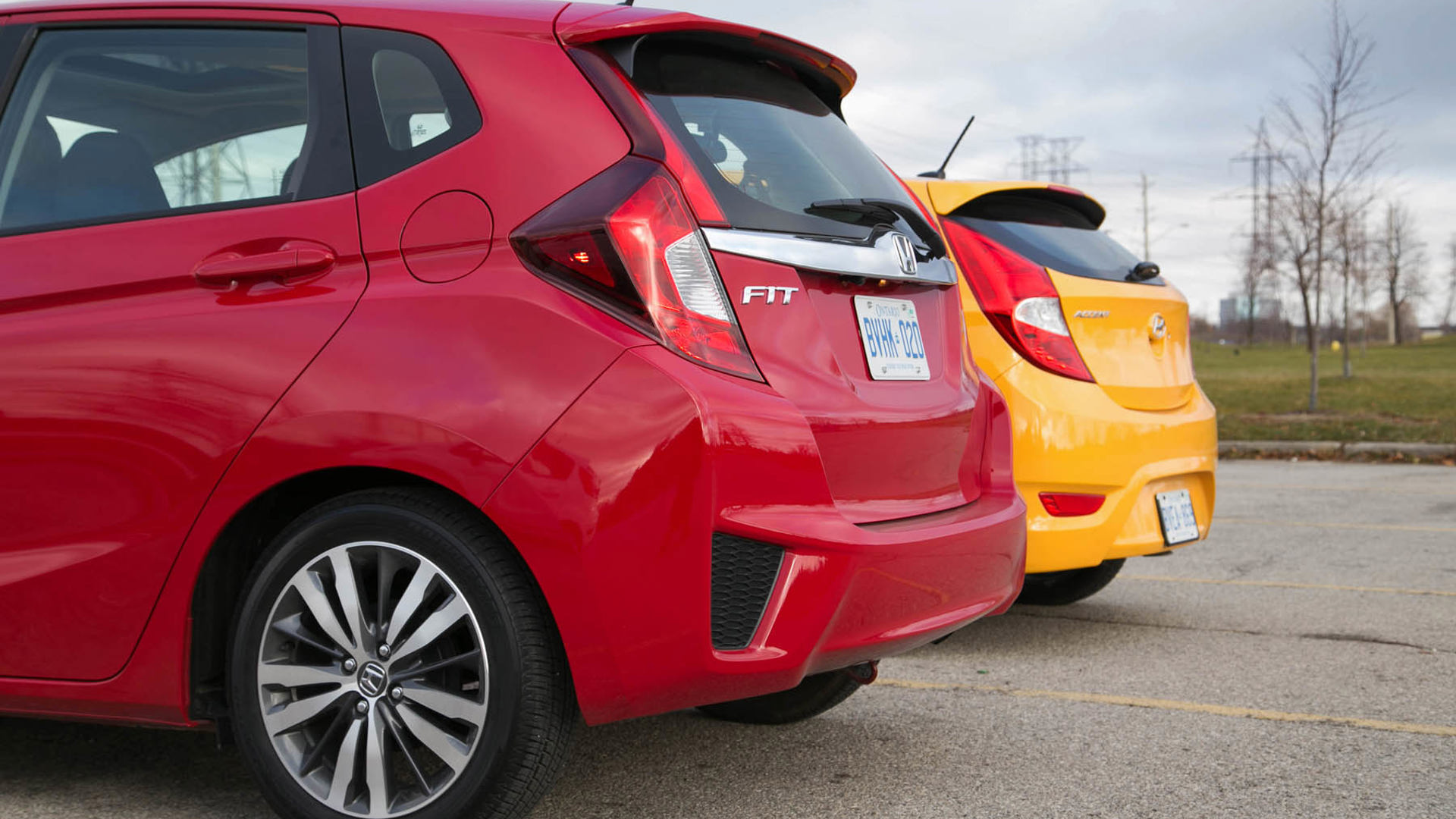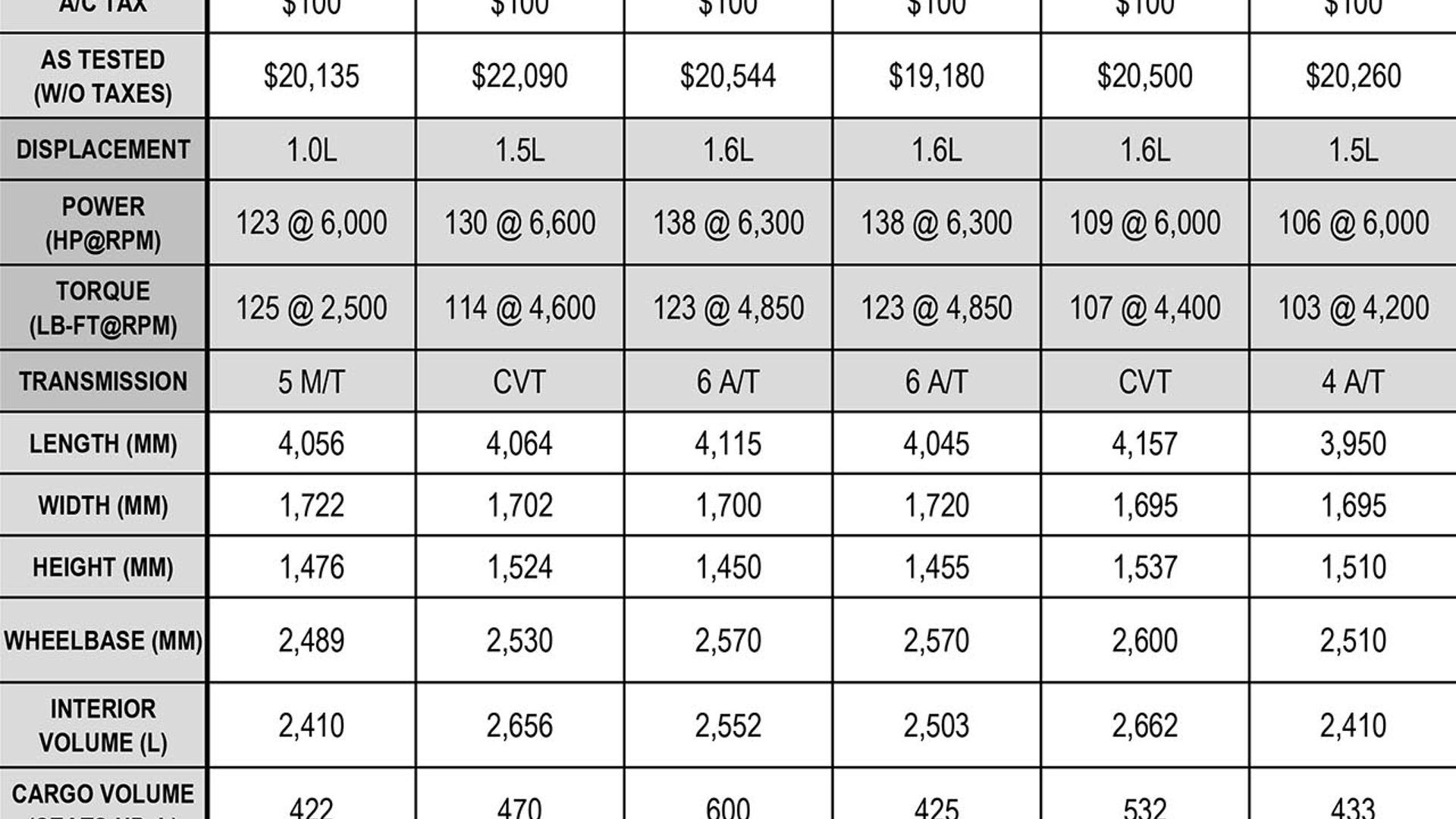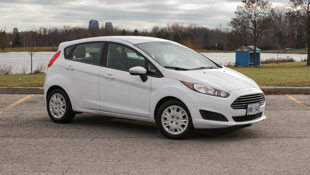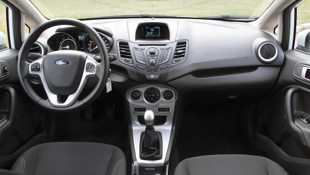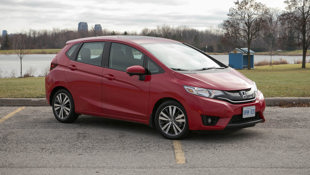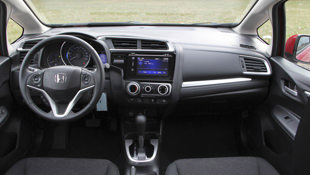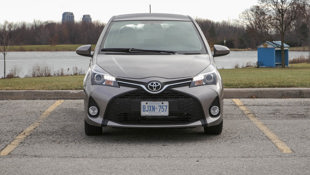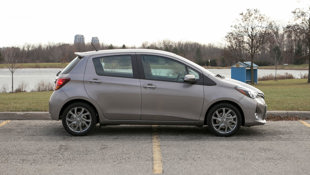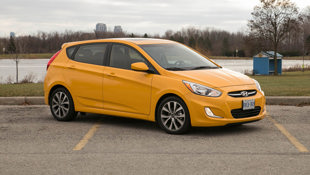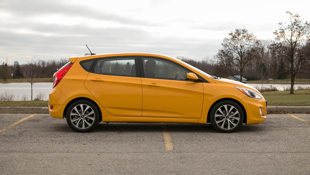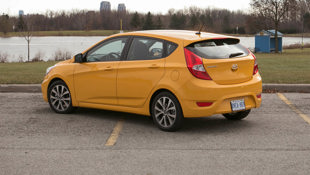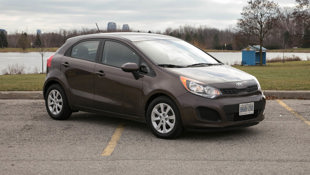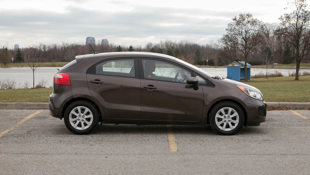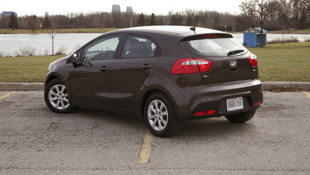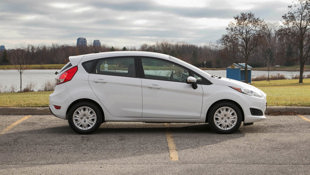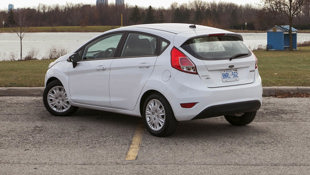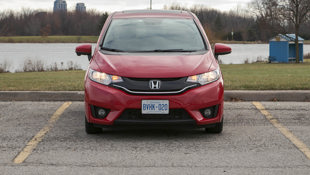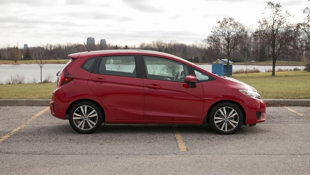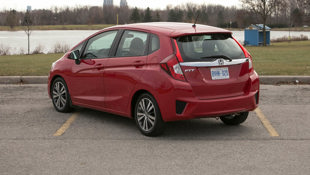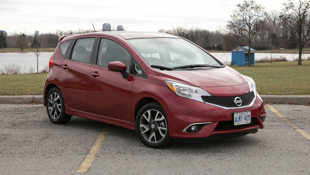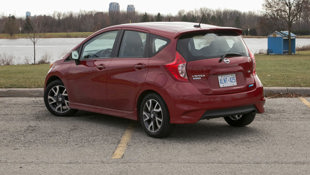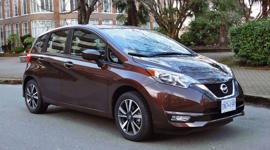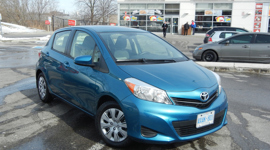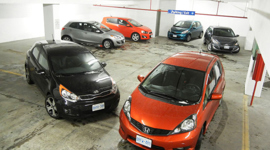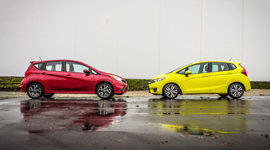Comparison Data
|
Base Price
$17,665
|
$18,849
|
$17,395
|
$16,675
|
$19,195
|
$18,698
|
|---|---|---|---|---|---|
|
A/C Tax
$100
|
$100
|
$100
|
$100
|
$100
|
$100
|
|
Destination Fee
$1,495
|
$1,595
|
$1,485
|
$1,565
|
$1,495
|
$1,567
|
|
Price as Tested
$20,260
|
$20,544
|
$19,180
|
$20,135
|
$22,090
|
$20,500
|
|
Optional Equipment
$1,000 (Four-speed automatic)
|
None
|
$200 (Colour charge)
|
$1,795 (SE manual EcoBoost package – $1,295; Comfort Package – $500)
|
CVT $1,300
|
Metallic Pearl Paint - $135
|
Review by Lesley Wimbush, Jacob Black, Jeff Wilson and Jonathan Yarkony
Photos by Jeff Wilson and Jonathan Yarkony
Introduction, Lesley Wimbush
Once upon a time, the subcompact car was cheap, but it certainly wasn't cheerful. These were the cars that you settled for when your budget constraints had no further stretching room. Little more than tin boxes on wheels, they provided little more than rudimentary transport – with not much effort made as far as styling or craftsmanship went.
They may be small, but the roles they fill are huge. For the buyer in this demographic, the car is a major purchase, and one that must be considered carefully.
Fortunately with the increasing pressures upon automakers to produce better, more efficient and better-designed vehicles at an economical price, there has never been a better time to buy a subcompact hatch.
It really boiled down to the fine points when evaluating this group. They're all likeable, reliable vehicles – but in this segment, the holy trinity of fuel consumption, price, and cargo ability are the deciding factors.
Smaller cars are becoming more in vogue as the emphasis on fuel efficiency, emissions reduction and gridlock prevention grows – and as a result, this has become one of the most fiercely competitive segments in the industry. No longer is the consumer forced to endure dreadful plastics, dreary design and little effort towards comfort and quality.
The cars we've assembled for our comparison test are all terrific examples of their segment, as each one offers good fuel economy, decent build quality and practicality – with the sort of styling we never would have seen just a generation or two ago.
The value of having a team evaluation was brought home to us several times over the course of our two-day test. Though we're all seasoned testers, our experiences and tastes somewhat differ – and it was a reminder that the opinions and needs of the buying public are vast and varied too.
Yet it was surprising to see how these personal preferences played out.
Jeff Wilson and I thought the Ford Fiesta, the only entry with a manual gearbox, was simply brilliant in the snow, with its composed handling and ability to gear down to a stop. Yet Jonathan Yarkony disliked the steering feel, frustrated by the lack of traction control defeat button and was rather ambivalent to it overall. With his lanky frame and long legs, Jon was stuffed into the Yaris like the proverbial clown car – finding the seating position just too confined for comfort. The rest of us either didn't mind, or rather like the Yaris, although we all agreed that the lack of telescoping steering wheel was a major demerit point. Jacob wasn't exactly enamoured of the Honda Fit – granted it was the only one of the group not fitted with proper winter tires, so a thorough evaluation was almost impossible – but he hates that touchscreen HMI. Yet the Fit scored big points with the rest of the group for its incredible, TARDIS-like ability to accommodate just about any sort of cargo thrown at it, with an attractive new interior layout to boot.
The Versa Note took us all by surprise. Most of us remembered its predecessor, and the Note is a much more accommodating and well-crafted vehicle. Jacob was particularly smitten after the Note handled a vigorous drive loop in near-blizzard conditions with admirable aplomb.
When it came to the Korean entries, we all seemed to converge in a agreement: they featured pleasing powertrains and scored high in easy-to-drive factor, although the Rio has just that little extra pizzazz – and a slightly smaller price tag, too.
It really boiled down to the fine points when evaluating this group. They're all likeable, reliable vehicles – but in this segment, the holy trinity of fuel consumption, price, and cargo ability are the deciding factors.
6th Place: 2015 Toyota Yaris, Jeff Wilson
It used to be that if you purchased a Toyota Yaris (or formerly an Echo or Tercel), you were to be congratulated for choosing an incredibly sensible little machine. Efficient and virtually indestructible, the Yaris was elemental transportation for those who needed a car but didn’t want a car.
So when Toyota provided us this 2015 Yaris SE, I was drawn to it almost immediately thanks to its tidy proportions and funky looks; completely un-Toyota-like. While the new styling does make the little Toyota look like an anime character who’s angry for eating a lemon, it is distinctive and helped the Yaris stand out in the group. Beautifully finished with lustrous “Brown Sugar Metallic” paint and attractive titanium-coloured alloy wheels, the tiny Toyota looks like the fun-to-drive machine earlier Yarises never were.
Inside, the front seats also look the business with supportive bolstering, and they’re very comfy too. And as in every other contemporary Toyota, the controls are logically laid out and easy to use, even with gloves on. That is, with the exception of the infotainment system that’s been stuffed into the dashboard’s double-DIN outlet. With small buttons and a dull, finicky touchscreen, it’s at odds with the rest of the sensible layout.
Size matters in this category in a few different respects. Being small means that interior space and functionality are limited and that’s the case here, with the Yaris tying the diminutive Fiesta for smallest of the bunch. On the upside, it should make the Yaris easier to maneuver in tight spaces, like an underground parking garage. But with the largest turning circle and no backup camera available, the Yaris is not as well suited for many snug urban settings as some of the others here.
Where things really started to fall apart for the Yaris is when we took it out for a drive. While we certainly would not have asked for the abysmal winter storm we faced during our test drive day, the conditions did allow us to explore the performance limits of these cars at much lower speeds.
Despite motivating the lightest curb weight, Toyota’s 1.5L four-cylinder ekes out only 106 horsepower and 103 lb-ft of torque – both lowest in this test – and protests loudly in doing so while delivering only mid-pack fuel efficiency. The ABS and traction control are both quick to cut in and proved to be overzealous in the snow, the latter hampering forward motion where the more forgiving systems in cars like the Fiesta and Versa were helpful.
Editor Jacob Black suggested that the Yaris’s vague steering “made for a busy, disconcerting drive in the less than ideal conditions. The Yaris wobbled about when it should have been stable.”
While Toyota’s design team has given new life to the Yaris thanks to its snazzy new appearance, the mechanical bits and interior practicality needs a redo to keep the car competitive. As Senior Editor Yarkony proclaims, “It’s just not enough car in any particular way. This will be the choice of those that worship at the church of Toyota reliability.”
Pricing: 2015 Toyota Yaris
Base Price (5-door LE): $15,965
Base Price (5-door SE): $17,665
Options: $1,000 (Four-speed automatic)
A/C Tax: $100
Freight & PDI: $1,495
Price as tested: $20,260
Observed fuel consumption: 9.5/100 km
EPA Fuel Consumption: 7.8/6.5/7.4 L/100 km city/highway/combined
Warranty: 3 years/60,000 km; 5 years/100,000 km powertrain; 5 years/unlimited distance corrosion perforation; 3 years/60,000 km 24-hour roadside assistance
5th Place: 2015 Hyundai Accent, Jonathan Yarkony
In our last subcompact comparison, the Hyundai Accent claimed superiority in fuel consumption and value along with refinement to earn it the crown, and Michael Bettencourt’s praises as “so polished, so sophisticated… this is the blue blood member of proper subcompact society.”
Well, it remains a model of refinement, judged to have the quietest ride, and the most pleasing powertrain, not surprising given its 138 hp (best in test, along with its Rio cousin) and 123 lb-ft of torque. In this company, the Accent moves along smartly, its 1,189 kg neither most nor least, so it feels comfortable at any speed and never struggles once underway. Unfortunately, with power comes a penalty in fuel consumption, its EPA combined 7.8 L/100 km worst in this group and in heavy snow and urban driving on the day of testing it showed 11.1 – in stark contrast to its efficient results in the previous comparison, where it was best on the day of judgment.
It has also been eclipsed in quality, Jacob noting some interior panel gaps and Jeff pointing out flaws in the paint application, and the interior styling seemed to favour form over function. Noah noted “When I sat down, I found the interior to be nicely styled, thinking at first ‘hmm, this looks really nice.’ However, that wore off within about a minute. I didn't find the interface to be particularly well laid-out and the dash was a little boring.”
To cap it off, the Hyundai doesn’t seem to offer quite the value against refreshed competition. The Rio5 was similarly equipped for a lower price (excepting the sunroof and 16-inch alloys that come with the Accent’s Sport Appearance Package), and the Versa Note had some more desirable features (though not heated seats like the Accent) for about the same price of just over $20K with Freight and PDI.
A couple judges appreciated its sleek design and vibrant yellow colour, but overall the group set it mid-pack for its styling inside and out. Its elaborate styling does not impinge on practicality, much. The door openings are wide thanks to a fairly long wheelbase and ease of access is reasonably easy, and with telescoping steering, adjustable seat and conventional proportions, the driving position was favourable for most of our drivers, second only to the Fiesta, and Jeff found it felt like “a comfortable pair of slippers.”
While the ride is reasonably comfortable, it’s an uneventful drive, defaulting to boring for the most part, though a couple judges outright disliked its steering and handling, but of greater concern was the visibility, its styling-compromised sightlines making driving a little less easy than our best and ease of parking falling to worst in the group.
And although Hyundai claims the trunk can accommodate 600 L (of sand, presumably) we didn’t see a marked difference or superiority in its trunk, and it has nowhere near the cargo flexibility and ultimate capacity as the Versa Note and Fit Magic Seats with seats folded, not to mention its relatively tall liftover height compared to the others.
From winner to straggler, fewer judges this time around found favour with the little Hyundai's brave new looks, and there was little here to set it above any of the recent entries in this field even if it is a good solid entry, “an easy car to live with,” as noted by Lesley, with a strong, if slightly thirsty powertrain.
Pricing: 2015 Hyundai Accent Sport Appearance Package
Base Price (5-door L): $13,899
Base Price (5-door Sport Appearance Package): $18,849
Options: None
A/C Tax: $100
Freight & PDI: $1,595
Price as tested: $20,544
Observed fuel consumption: 11.1 L/100 km
EPA Fuel Consumption: 9.0/6.4/7.8 L/100 km city/highway/combined
Warranty: 5 years/100,000 km; 5 years/100,000 km powertrain; 5 years/unlimited distance corrosion perforation; 5 years/unlimited distance 24-hour roadside assistance
4th Place: 2015 Kia Rio5, Jonathan Yarkony
It truly is amazing how different the Rio5 and Accent manage to be considering their common platform roots, but I agree with Jeff in that “it’s not surprising that the Rio placed next to the Accent, its kissing cousin.” Though they share the same wheelbase and powertrain, almost every other dimension differs ever so slightly, from length and track to cargo capacity and turning radius, not to mention they are polar opposites in styling. While there are differences, both are quintessential and conventional subcompacts. Unfortunately for Hyundai and Kia, a brave new era is upon us in the subcompact segment, with the Fit rewriting the playbook with its minivan-like flexibility, and finding a challenger in the Versa Note this time around.
Still, these are both superb cars as affordable and efficient transportation, but in an autoTRADER.ca comparison test, it’s not about how good you are, but how much better than your competitors. The Rio5’s looks were admired inside and out, but interior quality brought up the rear, with various hard plastics and “cheap” materials according to one observer. However, Jacob gave it an unequivocal thumbs up: “Even without the higher-trim UVO infotainment package it’s still feature packed and feels more premium inside than it ought to.” The brightly backlit gauges and modern layout and design (particularly the toggle switches) made those low-quality materials easier to bear, earning adjectives like “pretty” and “daring”. Didn’t hurt that we judged it to have the best ergonomics with a stereo that was easy to use and didn’t sound half bad.
The driver’s seat was mostly inoffensive, and even well-loved by Noah: “the Rio has the most comfortable seats of all of the competitors, hands down”, but the lack of telescoping steering column meant a comfortable driving position was hard to find for others. Like the Accent, seating and access front and back were good, and the trunk was suitable for basic needs (despite listing an impressive 532 L), but others were better.
Also like the Accent, its engine was a treat with 138 hp and 123 lb-ft managing its 1,145 kg curb weight with little effort, the six-speed automatic transmission slipping between gears unobtrusively, its ride and steering comfortable, making this an easy little car to drive. On the other hand, reduced visibility and lack of back-up camera make parking harder than it should be for such a small car with the best turning radius of the bunch.
Still, that was a minor quibble compared to the Rio5’s unimpressive fuel consumption: its EPA ratings 8.7/6.4/7.6 L/100 km city/highway/combined are falling off the pace of newer competitors, and the worst showing of any car with winter tires on the day of testing at a disastrous 11.5 L/100 km.
Jeff Wilson made an astute observation: “It's a shame Kia provided us the LX+ trim level of this car since the next-step-up EX would've been a better match for features and amenities (including that telescoping wheel) and still be mid-pack for pricing.” Indeed, with the EX’s 16-inch wheels, leather interior trim, driver armrest additional speakers, the UVO touchscreen audio system, back-up camera and auto headlights, the points it gained in features, value, driver comfort and interior quality would have been enough to bump it up onto the podium over our third place finisher, the $1,200 bump in price merely putting it on par with most of the others. In our opinion, the EX, with the automatic transmission standard, is the trim to look at for commuters and families considering a small, comfortable well-featured runabout. The Rio also earned brownie points for Kia’s 5-5-5 warranty, which was judged the most well-rounded in this group.
The Kia Rio5 is a lovely design inside and out, with reasonable practicality, features and likable driving characteristics, but needs work in the areas quality, innovation and efficiency to become a leader in the segment.
Pricing: 2015 Kia Rio 5-door LX+ AT
Base Price (5-door LX MT): $14,495
Base Price (5-door LX+ AT): $17,395
Options: $200 (Colour charge)
A/C Tax: $100
Freight & PDI: $1,485
Price as tested: $19,180
Observed fuel consumption: 11.5 L/100 km
EPA Fuel Consumption: 8.7/6.4/7.6 L/100 km city/highway/combined
Warranty: 5 years/100,000 km; 5 years/100,000 km powertrain; 5 years/unlimited distance corrosion perforation; 5 years/unlimited distance 24-hour roadside assistance
3rd Place: 2014 Ford Fiesta, Jeff Wilson
The results of this test could rightly be divided into the two winners and the rest of the group. The gulf dividing third place and second was significant amongst our testers and the Fiesta wormed its way up to third place thanks in no small part to its engine.
At 1.0 litre, the three-cylinder Ecoboost engine in the Fiesta displaces less than the largest Big Gulp cup, but with a turbo bolted on, the little Ford produced the most torque (125 lb-ft) moving the tiny white car with surprising gusto. Mated to the only manual transmission in the bunch (a five-speed), the Fiesta quickly became the car we all had the most fun horsing around in the snow. Melodic it’s not, with an engine note about as musical as a flatulent squirrel.
More importantly, the three-pot Fiesta proved to be the fuel sipper of the group, consuming considerably less fuel than the others, despite our hooliganism. This efficiency and the Ford’s excellent driving position and steering/braking feel were enough to help push the Fiesta this far up in the rankings despite its deficiencies.
And there are deficiencies with the Fiesta. For one, it’s not a pretty car, and while none of the vehicles in this test are jaw-droppers, when finished in white paint and wearing plastic wheel covers, the Fiesta ended up looking like a cheap government fleet car amongst the cool kid rides.
Inside, the Fiesta’s over-styled dash layout and cumbersome (and sometimes spastic) infotainment system drew some grumbles from our testers. But it was the chintzy materials and finishes, and woeful lack of practicality that prevented the Ford from being a real contender. Rear seat space is tight with legroom and headroom particularly scarce, and the cargo area requires a moderate lift to reach. And if you do manage to lift your heavy cargo into the Fiesta, you’d better hope it’s not too large because the Ford’s capacity is smallest here. Having the only rear seat in the test that doesn’t fold fully flat wasn’t winning any praise either.
Jacob sums up the Fiesta well saying, “It’s genuinely fun, with a great little gearbox that offered up more control and fun – but is fun what this segment is for?” While driving enjoyment will be a factor for some, this needs to be as practical a car as possible for most buyers. The Fiesta may have ended up in third place thanks to its drivetrain, but there is still a lot of work to be done here if Ford wants to compete with the top two cars in this segment.
Pricing: 2014 Ford Fiesta 1.0 SE Ecoboost
Base Price (5-door hatch SE): $16,675
Options: $1,795 (SE manual EcoBoost package – $1,295; Comfort Package – $500)
A/C Tax: $100
Freight & PDI: $1,565
Price as tested: $20,135
Observed fuel consumption: 8.4 L/100 km
EPA Fuel Consumption: 7.6/5.5/6.5 L/100 km city/highway/combined
Warranty: 3 years/60,000 km; 5 years/100,000 km powertrain; 5 years/unlimited distance corrosion perforation; 5 years/100,000 km 24-hour roadside assistance
2nd Place: 2015 Honda Fit*, Lesley Wimbush
*The Honda Fit we were provided was equipped with all-season tires. Driving impressions were conducted on a day that saw several centimetres of snowfall the night prior, and several more throughout the day of testing.
"Perfect" is a word open to infinite interpretations.
For instance, I consider a large Italian dark roast, full tank of gas, and an open road pretty close to perfection – but there are folks I actually like who'd rather grab a cold one and park it in front of the hockey game. Chacun à son goût.
By its very nature, the subcompact car segment is all about compromise – there's no pretense of perfection.
Leave it to the sports cars and exotics to specialize in stroking the outer limits of sensation, disdaining any concession whatsoever to practicality. In the premium market, compromise is tantamount to blasphemy, particularly when talking about purity of performance.
But our team of jellybean warriors are the masters of compromise, little unsung heroes of the roadway and jacks of virtually all trades of the automotive sector. Their owners depend upon them to adapt to just about every conceivable facet of family life. The best of them do that with the ease of chameleons.
But for me, only one came close to the perfect compromise: the Honda Fit. The character of the original may have been somewhat watered down in refinement, but what it loses in fun, it gains back in utility.
Granted, our tester was severely handicapped – the only one of the group to sport all-season tires on a day when winter had reduced most of Greater Toronto to immobile chaos – we lost one judge to impassable traffic on the 401 preventing his arrival. It was also, at $22,090, the most expensive by over a grand – and in this snack bracket, that matters.
Fortunately, most of us had already spent time with the Fit – on highway and city streets plus an autocross track during the recent Car of the Year testing process – and were already familiar with its handling and regular-weather performance characteristics.
Honda's compact five-door received an extensive makeover for 2015, with new sheet metal, chassis and drivetrain. It's fractionally shorter than the outgoing model, though it appears larger and more substantial thanks to its raised beltline and reduced greenhouse. But the important thing is that its slight increase in width and revised platform have given it more rear legroom than the Accord.
The Fit had already been a sales success for Honda, with its origami seat configuration offering Swiss Army knife levels of utility. But that quirky character lacked the sophistication to seriously appeal to more mature buyers. Fuel efficiency too, left something to be desired.
The Pokemon looks have given way to a tidier, more sculpted design, the screwed-up, anime face now appears intent and purposeful. Surprisingly, this makeover left our judges cold; collectively we ranked it last in terms of styling.
The plasticky-cuteness of the previous generation's cabin is gone, in its place is a more premium environment – albeit a rather busy one. The touchscreen interface requires familiarization time (why would they hide the volume control knob within it?) but there are now premium heated leather seats and available sunroof. The Fit scored high in interior ergonomics and quality, and about mid-pack for visual appeal.
The "Magic Seat” system returns, offering myriad ways to configure interior space, making the Fit the undisputed champion of interior flexibility with a perfect score and winning both cargo space and cabin storage categories hands down.
Economics play a huge role in this group and with the Fit's new, more powerful engine and two transmission choices comes better fuel economy: an EPA rating of 7.1 L/100 km city and 5.7 highway (with CVT) result in a combined 6.5, tied for best in test. Of course, this comes at the expense of performance, with more frugal yet less responsive steering, and an ultra-efficient yet ultimately boring CVT. Unfortunately, our tester earned low fuel scores as the harsh weather rendered it too dangerous to take on the highway with summer rubber. Jonathan theorized that the front wheels traveled over ten times the distance of the rears they were futilely spinning so much in the slick snow pack.
Despite the handicaps of high price and inferior tires, the Fit still came a very close second. I'd be willing to bet that with equal rubber, and a more inexpensive (and more fun) manual transmission, it would be a perfect Fit (sorry).
Pricing: 2015 Honda Fit EX
Base Price: $16,068
Base Price (EX): $19,195
Options: CVT $1,300
A/C Tax: $100
Freight & PDI: $1,495
Price as tested: $22,090
Observed fuel consumption: 11.6 L/100 km
EPA Fuel Consumption: 7.1/5.7/6.5 L/100 km city/highway/combined
Warranty: 3 years/60,000 km; 5 years/100,000 km powertrain; 5 years/unlimited distance corrosion perforation; 3 years/unlimited distance 24-hour roadside assistance
1st Place: 2015 Nissan Versa Note, Jacob Black
“Every dog has its day,” or so the saying goes. Only one of us (me) had the Versa Note earmarked as a contender heading into our two-day test, but fate intervened. The Fit almost overcame its 10 percent higher price tag even after the heavens unloaded a slushy mess on Toronto’s roads and the Fit’s all-season tires.
Even in regular conditions, the Versa Note and Honda Fit are neck and neck – as an example of how close this is, our west-coast brethren found the opposite result in their Versa Note vs Honda Fit comparison test. Ultimately, the Note was the better compromise and better performer on the day for us.
As Senior Editor Jonathan Yarkony understated, this was a “controversial win in a crucial segment”, but “a balance of value, excellent functionality, efficiency and ease of use earn the Versa Note a top step on the podium. Although things might have gone differently if weather had not been what it was, the Versa still deserves this win for being such a capable all-round performer and great value for the money.”
In fact, the Versa Note was my favourite of the cars all day. While handling and sportiness are not major contenders in this segment, the Versa Note thrilled me with its surprising skidability in the snow. Snowy roads can be fun in the right conditions – and the Versa Note handled my mucking about with serious composure. “This new Versa Note surprised the heck out of me,” Jeff enthused. “Everyone came away from their drive remarking how competent it is even in the miserable snowy conditions we faced – a testament to the controllability of the car.”
Lesley was likewise impressed by how far the little Nissan has come, but rightly pointed out the one flaw in the package. “Decent interior, terrific cargo space, better design… but the CVT is still a big nope for me,” she opined.
With less power than all but the Yaris at a meagre 109 hp and 107 lb-ft of torque we found the CVT was wound to unacceptable aural levels too often, but it still did little to dull our enthusiasm for the overall drive. Here again, the snow played a part in the Versa’s victory, with much of the others’ power advantage rendered redundant.
The livability aspects of the truly cavernous Versa Note were what scored it most points, with the best gauges and info screens and second best in overall usability. Ease of entry and rear seat comfort all went to the Nissan, as did ease of driving, sightlines, ride comfort and handling. A note on handling: The Fiesta’s lack of a traction control button hurt it in snowy conditions, and left Jonathan completely underwhelmed (and distracted).
Exterior styling and interior styling wins helped too, with the seats given a sexy orange stripe for extra “oooohhh”. Cargo was a close second to the Fit with the two-level cargo floor and the option of a fully flat floor helping it stand out above the others. The Fit’s poor showing in usability and ergonomics is important – these cars are often purchased by new drivers, and elderly drivers – demographics who value simplicity and ease of use in their chariots. That discrepancy helped the Note overcome the Fit’s excellent scores for amenities. The Versa Note had a back-up camera, text-to-voice Bluetooth and a suite of other features, but was nearly vetoed by me on principle due to lack of heated seats.
It’s winter for crying out loud!
Still, the extremely large cabin heated up quickly and those uber-comfortable cloth seats with their funky orange stripe were soon forgiven. Being second to the mind-blowingly efficient turbo three-cylinder Fiesta in fuel economy also contributed to the Nissan’s win.
For me, it was the sheer size of the passenger area that blew me away. At 2,665 L it was by far and away the pick of the bunch. The width of the Versa Note further ads to its spacious atmosphere – though means it’s not a great car for the romantically inclined.
So there you have it, on a day when some of the competition’s edge was muted, a mix of big wins and close seconds saw the Nissan Versa Note’s perfect blend of value, efficiency, practicality and livability rise to the top, a controversial, but well-deserved victory.
Pricing: 2015 Nissan Versa Note 1.6 SR
Base Price: $14,298
Base Price (1.6 SR): $18,698
Options: Metallic Pearl Paint - $135
A/C Tax: $100
Freight & PDI: $1,567
Price as tested: $20,500
Observed fuel consumption: 9.4 L/100 km
EPA Fuel Consumption: 7.6/5.9/6.7 L/100 km city/highway/combined
Warranty: 3 years/60,000 km; 5 years/100,000 km powertrain; 5 years/unlimited distance corrosion perforation; 3 years/unlimited distance 24-hour roadside assistance
